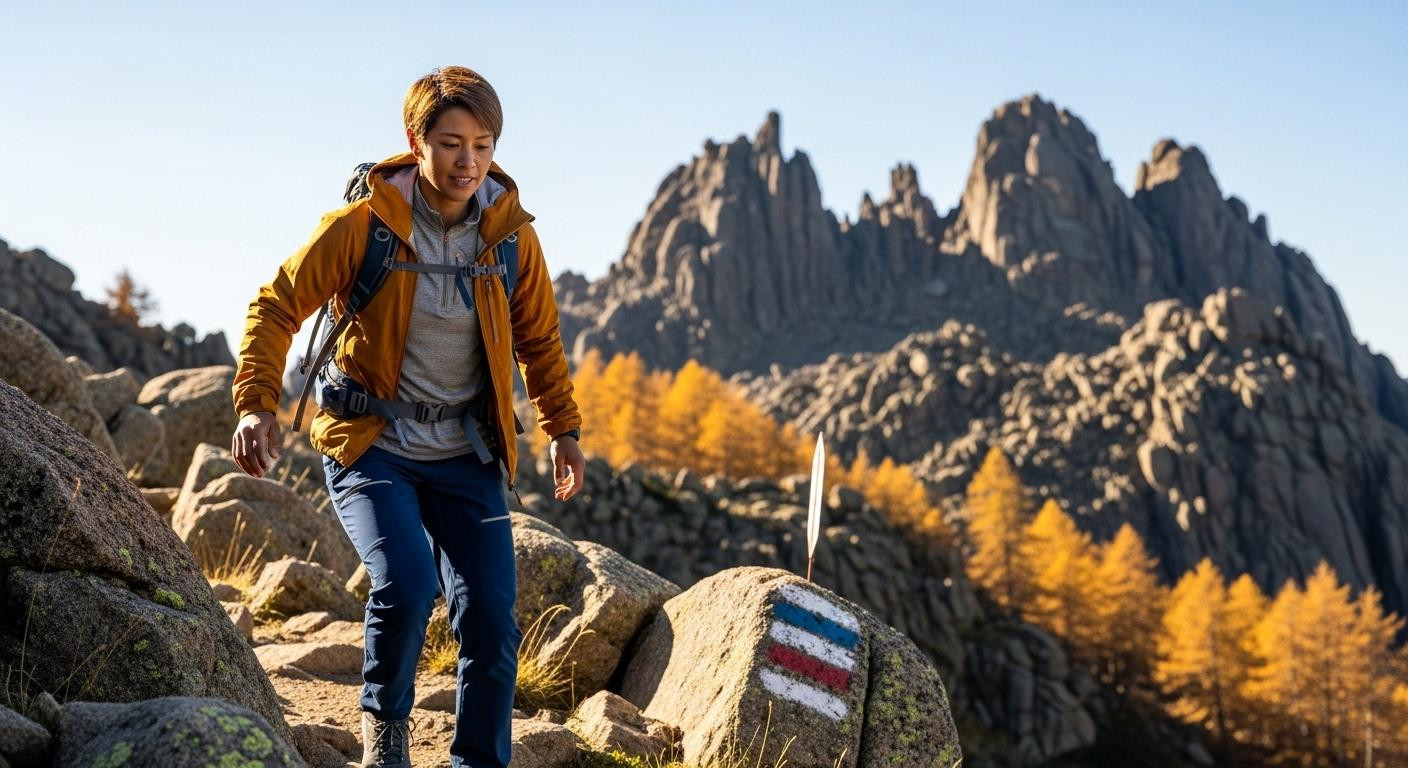Dawn breaks over Bavella’s granite needles as pink light floods 130-million-year-old stone. Below, coastal tourists queue for beach parking while mountain mist carries pine resin and the silence of centuries. This is the Corsica 340,000 residents protect: not postcard beaches but alpine wilderness where polyphonic singing echoes through chestnut forests and the GR20’s 7,700-foot ascent rewrites what Mediterranean travel means.
Where granite meets Mediterranean sky
The jagged spires of Bavella rise like cathedral towers against turquoise distant sea. At 3,900 feet, these granite formations display pinkish hues that shift from slate gray to rose gold as morning light touches ancient stone. The contrast strikes immediately: below, coastal Corsica bustles with 3 million annual visitors, while up here, silence dominates.
Corsica’s mountainous spine runs north-south through the island’s heart. Monte Cinto, the highest peak at 8,878 feet, offers views across both Mediterranean and alpine landscapes. From Calvi in the north to Bonifacio’s limestone cliffs 125 miles south, this granite backbone preserves what coastal development cannot touch.
Slovenia’s 6,200 miles of hiking trails offer similar alpine authenticity, but Corsica’s mountains hold something different: a living culture where Corsican dialect survives in daily conversation and medieval traditions continue unchanged.
The mountain rituals tourists never witness
Granite cathedrals at dawn
The Bavella Needles transform each morning as first light touches their surfaces. For exactly 17 minutes, granite shifts from gray to peach to rose gold before settling into warm amber tones. Glacial lakes Melo and Capitello mirror these peaks perfectly on windless mornings, creating reflections that seem painted rather than real.
Village architecture tells stories coastal resorts cannot. Stone-built settlements like Corte feature tight medieval alleys, ochre facades, and terracotta roofs unchanged since the 13th century. These mountain towns served as centers of Corsican resistance when the island was ceded to France in 1769.
Where Corsican identity lives
Polyphonic singing called paghjella echoes through village churches on Sunday evenings. This UNESCO-listed tradition survives strongest in mountain communities where Corsican dialect remains the primary language for over 65% of daily conversations. Coastal towns speak primarily French: mountain villages preserve the island’s soul.
The GR20 hiking trail, developed in the late 1970s, now protects this wilderness while providing access to Europe’s most challenging long-distance trek. At 112 miles with 41,863 feet of total elevation gain, it demands respect while rewarding persistence with views no coastal experience can match.
What three days on the GR20 actually changes
The 41,863-foot ascent that slows time
Mountain refuges cost $22-44 per night in dormitory-style accommodation, offering basic shelter at elevations where silence becomes tangible. Recent visitor surveys reveal that 82% of October hikers complete the trail, compared to 75% who attempt it in summer heat. The autumn completion rate reflects optimal conditions: 59-77°F days and 41-59°F nights.
This 300-resident Pyrenees town understands similar mountain safety challenges, but Corsica’s granite terrain creates unique obstacles. Via ferrata chains assist hikers through sections like Cirque de la Solitude, where exposure demands both physical and mental preparation.
Food that tastes of mountain stone
Pulenda, chestnut flour polenta, costs $13-16 in mountain village restaurants and connects diners to generations of Corsican survival. Figatellu sausage ($20-24) and fiadone cheesecake ($7-9) complete meals that taste of wild herbs and granite-filtered spring water. These dishes remain unchanged in recipes passed through families for centuries.
Mountain restaurants source ingredients within 15 miles of their kitchens. Chestnut forests in the Castagniccia region provide flour milled the same way since medieval times, while wild boar and goat products come from animals that graze granite meadows above 3,000 feet elevation.
October silence over Vizzavona forest
Autumn transforms Corsica’s mountains into a canvas of scarlet and gold. Chestnut leaves turn brilliant orange while oak forests display deep reds against granite backdrops. Morning mist clings to valleys that have remained unchanged since Roman times, creating scenes that feel timeless rather than touristic.
This tranquility contrasts sharply with coastal chaos: while beach resorts process thousands daily, mountain trails in October host maybe 30 hikers per day across 112 miles. This 2,000-year-old cave in France offers similar healing through ancient silence, but Corsica’s peaks provide that restoration while maintaining accessibility for determined hikers.
The cost difference tells the story: mountain-based itineraries run 25-30% less expensive than coastal equivalents, with accommodation from $70-165 per night compared to coastal rates of $143-220 for similar quality.
Your questions about why Corsica’s mountains are its true secret answered
When should I hike to avoid crowds but keep good weather?
October through November offers ideal conditions: 59-75°F temperatures, clear skies, and accommodation costs 15-18% lower than peak season. Autumn foliage peaks October 15-27, while shoulder season brings 46% fewer hikers per mile compared to summer months. Refuge bookings require only 10-14 days advance notice versus 60+ days in July-August.
What makes Corsican mountain culture different from alpine traditions?
Corsican dialect preservation, paghjella polyphonic singing, and chestnut-based cuisine create cultural depth coastal tourism cannot access. Mountain communities like Corte maintain 13th-century architecture while preserving traditions that disappeared elsewhere. What 5,500 Luberon vignerons serve demonstrates similar regional authenticity, but Corsica’s isolation has preserved practices lost on the mainland.
How does the GR20 compare to other European mountain trails?
At 112 miles with 41,863 feet of total ascent, the GR20 proves technically harder than the Tour du Mont Blanc while costing 40-50% less. Refuge accommodation runs $22-44 compared to $66-88 for Alpine equivalents. The trail offers rawer wilderness with fewer commercialized sections, creating an experience closer to backcountry exploration than European hiking tourism.
Evening light floods Monte Rotondo’s glacial cirque as amber washes over granite peaks. Below, ferry lights blink toward Nice and the world of coastal tourism. Up here, pine needles crunch underfoot and spring water tastes of ancient stone, unchanged since Mediterranean meant wild rather than resort.
